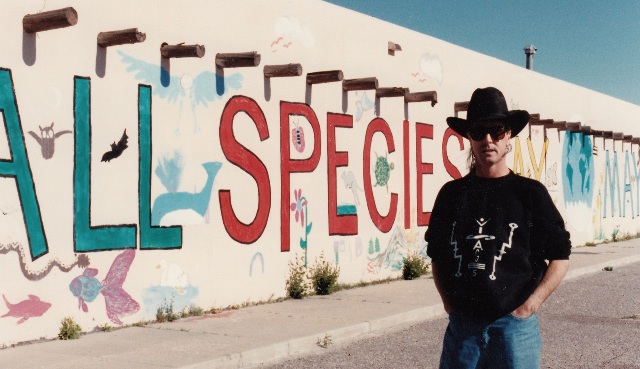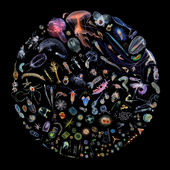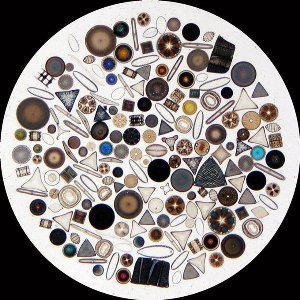File:All species day with homo sapien in Santa Fe .jpg
All_species_day_with_homo_sapien_in_Santa_Fe_.jpg (640 × 369 pixels, file size: 98 KB, MIME type: image/jpeg)
<addthis />
Steve Schmidt, your greenPolicy360 siterunner ...
- On All Species Day
- Looking back and looking forward to the challenges of affirming and protecting diversity of life in the midst of the "Sixth Extinction"
- In the city of 'Santa Fe' named in memory of the 'holy faith' of St. Francis, the patron saint of animals and ecology
- And a tip of the hat to the first Catholic pope to choose to name himself after St. Francis, as the Catholic Church sets forth in a green direction
○ ○ ○ ○ ○ ○ ○ ○ ○ ○ ○ ○ ○ ○ ○ ○ ○ ○ ○
http://www.greenpolicy360.net/w/All_Species_Day
http://earthstonestation.com/2012/05/09/all-species-day/
○ ○ ○ ○ ○ ○ ○ ○ ○ ○ ○ ○ ○ ○ ○ ○ ○ ○ ○ ○ ○ ○
Biodiversity, Small and Large
The early Greeks and Romans had a well established set of taxonomic names for species of animals and plants, based upon the macroscopically observable characteristics of organisms, with Aristotle being the chief architect of this codification; even earlier, the Egyptians and Cretans developed basic symbols and names for species important in farming and culture. It was not until the year 1686 when English naturalist John Ray introduced the concept that species were distinguished by inevitably producing the same species, though considerable morphological variation was observed within a species. Carl Linnaeus (1707–1778) formalized the taxonomic rank of species, and developed the two part naming system of binomial nomenclature that survives to current times, with genus and species names in Latin form.
IPBES
Intergovernmental Science-Policy Platform on Biodiversity and Ecosystem Services / https://www.ipbes.net
Biodiversity Crisis
'The planet’s support systems are so stretched that we face widespread species extinctions and mass human migration unless urgent action is taken'
IPBES Report (2019), Biodiversity Crisis, Extinction Era
• https://www.greenpolicy360.net/w/Extinction
“The loss of species, ecosystems and genetic diversity is already a global and generational threat to human well-being. Protecting the invaluable contributions of nature to people will be the defining challenge of decades to come. Policies, efforts and actions –- at every level -- will only succeed, however, when based on the best knowledge and evidence. This is what the IPBES Global Assessment provides.”
“We are at a crossroads. The historic and current degradation and destruction of nature undermine human well-being for current and countless future generations... Land degradation, biodiversity loss and climate change are three different faces of the same central challenge: the increasingly dangerous impact of our choices on the health of our natural environment.”
– Sir Robert Watson, IPBES Chair
○
Estimation of species numbers
https://en.wikipedia.org/wiki/Species
Since most of the planet's species are deemed to be undiscovered, it is exceedingly difficult even to estimate the total number of species on Earth. An 2011 innovative study estimated the total number of species to be about 8.7 million, with around 86 percent of which are presently undiscovered.[2] The following represents a rough approximation of the number of species by taxonomic group, with ranges given for varying estimates of the species total numbers:
Total species: 7,000,000 to 100,000,000 (the lower number reflecting described species and the higher based upon estimates of Earth's species):
Bacteria: 5,000,000 to 10,000,000[3]
Archaea: 20,000 (based upon only marine species) [4]
Eukarya: 1,660,000
Of the described eukarya species 1,600,000 based on described species, including:
297,326 plants, including:
15,000 mosses
12,000 ferns
1,025 fern allies
980 gymnosperms
258,650 angiosperms
199,350 dicotyledons
59,300 monocotyledons
9,671 red and green algae
2,849 brown algae
100,000 fungi (of an estimated total 1,500,000 other non-animals) including:
25,000 lichens,
16,000 mushrooms
30,000 red, brown and blue-green molds
17,000 conidial fungi
1,260,000 animals, including:
1,203,375 invertebrates:
950,000 insects
81,000 mollusks
50,000 crustaceans
2175 corals
130,200 others
59,811 vertebrates:
29,300 fish
6199 amphibians
8240 reptiles
9956 birds
5416 mammals
And the unseen and unknown species
○ ○ ○ ○ ○ ○ ○
○ ○ ○ ○ ○ ○ ○
Endangered
Endangered species...
http://www.eoearth.org/view/article/152414/
○ ○ ○ ○ ○ ○ ○ ○ ○ ○ ○ ○ ○
A Generational Challenge
Warming Oceans
Phytoplankton & Photosynthesis
○ ○ ○ ○ ○ ○ ○ ○ ○ ○ ○
Biodiversity & Extinction
○
File history
Click on a date/time to view the file as it appeared at that time.
| Date/Time | Thumbnail | Dimensions | User | Comment | |
|---|---|---|---|---|---|
| current | 12:48, 24 September 2015 |  | 640 × 369 (98 KB) | Siterunner (talk | contribs) | http://www.greenpolicy360.net/w/Tree_of_Life Category:Biodiversity Category:Green Graphics |
You cannot overwrite this file.
File usage
- About Us
- Biodiversity
- Biosphere
- Bioneers
- Earth Science
- Extinction
- Green Graphics
- Santa Fe
- New Mexico
- Biogeosciences
- Climate Change
- Climate Policy
- Earth Observations
- Ecology Studies
- Ecoregions
- Environmental Security
- Forest
- Microbiology
- Microorganism
- Oceans
- Ocean Science
- Planet Citizens
- Planet Citizens, Planet Scientists
- Resilience
- Soil
- Sustainability
- Whole Earth
- Zoology




